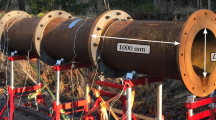Abstract
Three-dimensional (3-D) detonation structure transformations from rectangular and diagonal modes into spinning modes in a narrow square tube are investigated by high-resolution simulation. Numerical simulations are performed with a Riemann solver of the HLLC-type, new cell-based structured adaptive mesh refinement data structure, high-order, parallel adaptive mesh refinement reactive flow code. A simplified one-step kinetic reaction model is used to reveal the 3-D detonation structure. The four different types of initial disturbances applied in the ZND profiles lead to the structures of rectangular in phase, rectangular out of phase, rectangular partial out of phase and diagonal, respectively, during the initial stages of detonation propagation. Eventually, all these detonation structures evolve into the self-sustained spinning detonations. The asymmetric disturbance leads to a stable spinning detonation much faster than the rest. The important features in the formation of spinning detonation are revealed using a 3-D visualization, and a remarkable qualitative agreement with experimental and numerical results is obtained with respect to the transverse wave dynamics and detonation front structures. The transverse wave collisions produce the unburnt gas pockets and the energy to sustain the detonation front propagation and distortion. The periodic pressure oscillation of front plays a complex role as it shifts the reaction zone structure with an accompanying change in the driving energy of transition and the detonation parameters which result in the more distorted front and the unstable detonation. Eventually, the unstable distorted detonation evolves into a spinning detonation.






















Similar content being viewed by others
References
Fickett, W., Davis, W.C.: Detonation. University of California Press, Berkeley (1979)
Strehlow, R.A., Biller, J.R.: On the strength of transverse waves in gaseous detonations. Combust. Flame 13, 577–582 (1969)
Strehlow, R.A.: Multi-dimensional detonation wave structure. Astronaut. Acta 15(5), 345–357 (1970)
Takai, R., Yoneda, K., Hikita, T.: Study of detonation wave structure. Proc. Combust. Inst. 15, 69–78 (1975)
Hanana, M., Lefebvre, M.H., Van Tiggelen, P.J.: Pressure profiles in detonation cells with rectangular and diagonal structures. Shock Waves 11, 77–88 (2001)
Lee, J.H.S.: The Detonation Phenomena. Cambridge University Press, Cambridge (2008)
Lee, J.H.S., Soloukhin, R., Oppenheim, A.K.: Current views on gaseous detonation. Acta Astronaut 14, 565–584 (1969)
Mach, P.: Bifurcating Mach Shock Reflections with Application to Detonation Structure. Master thesis, University of Ottawa (2011)
Bourlioux, A., Majda, A.J.: Theoretical and numerical structure for unstable two-dimensional detonations. Combust. Flame 90, 211–229 (1992)
Oran, E.S., Kailasanath, K., Guirguis, R.H.: Numerical simulations of the development and structure of detonations. Prog. Aeronaut. Astronaut. 114, 155–169 (1998)
Gamezo, V.N., Desbordes, D., Oran, E.S.: Formation and evolution of two-dimensional cellular detonations. Combust. Flame 116, 154–165 (1999)
Shepherd, J.E., Pintgen, F., Austin, J.M., Eckett, C.A.: The structure of the detonation front in gases. In: 40th AIAA Aerospace Sciences Meeting, Reno, NV. AIAA paper 2002–0773 (2002)
Hu, X.Y., Zhang, D.L., Khoo, B.C., Jiang, Z.L.: The cellular structure of a two-dimensional \(\text{ H }_{2}/\text{ O }_{2}\)/Ar detonation wave. Combust. Theory Model. 8, 339–359 (2004)
Mahmoudi, Y., Mazaheri, K.: High resolution numerical simulation of the structure of 2-D gaseous detonations. Proc. Combust. Inst. 33, 2187–2194 (2011)
Kessler, D.A., Gamezo, V.N., Oran, E.S.: Multilevel detonation cell structures in methane-air mixtures. Proc. Combust. Inst. 33, 2211–2218 (2011)
Williams, D.N., Bauwens, L., Oran, E.S.: Detailed structure and propagation of three-dimensional detonations. Proc. Combust. Inst. 26, 2991–2998 (1996)
Tsuboi, N., Katoh, S., Hayashi, K.: Three-dimensional numerical simulation for hydrogen/air detonation: rectangular and diagonal structures. Proc. Combust. Inst. 29, 2783–2788 (2002)
Eto, K., Tsuboi, N., Hayashi, A.K.: Numerical study on three dimensional C-J detonation waves: detailed propagating mechanism and existence of OH radical. Proc. Comb. Inst. 30, 1907–1913 (2005)
Tsuboi, N., Katoh, S., Hayashi, K.: Detailed structure of spinning detonation in a circular tube. Combust. Flame 149, 144–161 (2007)
Tsuboi, N., Asahara, M., Eto, K., Hayashi, A.K.: Numerical simulation of spinning detonation in square tube. Shock Waves 18, 329–344 (2008)
Tsuboi, N., Hayashi, A.K., Koshi, M.: Energy release effect of mixture on single spinning detonation structure. Proc. Comb. Inst. 32, 2405–2412 (2009)
Deiterding, R.: Parallel Adaptive Simulation of Multi-Dimensional Detonation Structures. University at Cottbus, Ph.D. diss. (2003)
He, H.: Numerical Simulations of Unsteady Flows in a Pulse Detonation Engine by the Space-Time Conservation Element and Solution Element Method. The Ohio State University, Ph.D. diss. (2006)
Deledicque, V.: Modeling and Simulation of Multidimensional Compressible Flows of Gaseous and Heterogeneous Reactive Mixtures. Ph.D. diss., Universit’e Libre de Bruxelles (2007)
Ji, H., Lien, F.S., Yee, E.: A new adaptive mesh refinement data structure with an application to detonation. J. Comput. Phys. 229(23), 8981–8993 (2010)
Dou, H.S., Khoo, B.C.: Effect of initial disturbance on the detonation front structure of a narrow duct. Shock Waves 20(2), 163–173 (2010)
Ji, H., Lien, F.S., Yee, E.: Numerical simulation of detonation using an adaptive Cartesian cut-cell method combined with a cell-merging technique. Comput. Fluids 39, 1041–1057 (2010)
Edwards, D.H., Parry, D.J., Jones, A.T.: The structure of the wave front in spinning detonation. J. Fluid Mech 26(2), 321–336 (1966)
Huang, Y., Tang, H., Li, J., Wang, J.: Deflagration to detonation transition of kerosene-air mixtures in a small-scale pulse detonation engine. Proc. Inst. Mech. Eng. Part G J. Aerosp. Eng. 225(4), 441–448 (2011)
Acknowledgments
This research was carried out in collaboration with Waterloo CFD Engineering Consulting Inc. The computations conducted in this study were made possible by the facilities of the Shared Hierarchical Academic Research Computing Network (SHARCNET). This research was also supported by National Natural Science Foundation of China (50776045) and Graduate Research and Innovation Fund of Jiangsu Province (CX09B_078Z). The first author would like to thank Dr. K. J. Hsieh, Dr. Meishen Li and Jim Kuo in University of Waterloo for their supports when the author visited their group.
Author information
Authors and Affiliations
Corresponding author
Additional information
Communicated by E. V. Timofeev.
Rights and permissions
About this article
Cite this article
Huang, Y., Ji, H., Lien, F. et al. Numerical study of three-dimensional detonation structure transformations in a narrow square tube: from rectangular and diagonal modes into spinning modes. Shock Waves 24, 375–392 (2014). https://doi.org/10.1007/s00193-014-0499-2
Received:
Revised:
Accepted:
Published:
Issue Date:
DOI: https://doi.org/10.1007/s00193-014-0499-2




